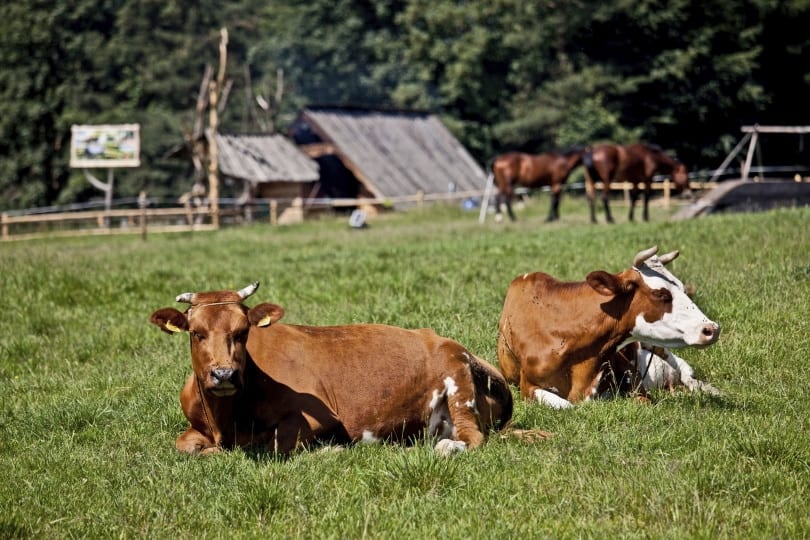The Simbrah breed was developed in the United States and has kept growing in popularity since. The breed is the result of crossbreeding Simmental cattle with Brahman and was specifically created to withstand extreme temperatures.
The Simbrah isn’t just known for extreme adaptability in different environments; these cattle have taken on a mix of sought-after attributes from both the Simmental and Brahman which has gained them worldwide interest. Here we’ll look at this unique composite breed and what makes them stand out.

Quick Facts About Simbrah Cattle
| Breed Name: | Simbrah |
| Place of Origin: | United States |
| Uses: | Beef, Dairy |
| Bull (Male) Size: | 1,800 – 2,500 pounds |
| Cow (Female) Size: | 1,100 – 1,500 pounds |
| Color: | Red and White, Black and White, Red, Black |
| Lifespan: | 15 – 20 years |
| Climate Tolerance: | Any climate |
| Care Level: | Intermediate |
| Production: | Meat |
Simbrah Cattle Origins
The Simbrah was first developed on the Gulf Coast of the United States during the 1960s. Some cattlemen had begun breeding experiments with the Brahman and Simmental cattle breeds to produce a breed that had great tolerance to the hot and humid conditions of the area.
The crossbreeding of these two breeds eventually led to the Simbrah. The American Simmental Association maintains the Simbrah breed registry. To be designated a purebred Simbrah, the cattle must be 5/8 Simmental blood and 3/8 Brahman or Zebu blood. Other combinations must consist of at least 1/8 Simmental, 1/8 Brahman, and no more than 3/8 other cattle breeds are registered as a percentage of Simbrah.

Simbrah Cattle Characteristics
Simbrah takes on characteristics from both parent breeds and is built for survival. These animals are alert and typically even-tempered. This is a very structurally sound breed that is designed to be as economical as possible.
The cows are well known for their superior fertility and maternal instincts. Not only are they highly protective of their calves, but they are also great milk producers. They are very rapid growers that mature quickly and can be bred as early as 14 to 15 months of age. In addition, they can be kept in production status throughout most of their lifetime.
The breed was created to handle the intense humidity and heat of the United States’ Gulf Coast, so their heat tolerance is incredible. Though bred for hot, humid conditions, the breed does gain a thicker coat that has given them some hardiness in the cold-weather regions of the Northeastern and Northwestern United States, withstanding subzero temperatures as well.
Simbrahs do not have any color requirements for registration status, but the breed is primarily either red or black with the occasional white markings. Their skin is either red or black, which includes the pigmentation around the eyes. This helps protect against sun damage. Their coat is sleek and fine during the summertime and does a great job reflecting the rays of the sun. They inherit the dewlap from the Brahman cattle, which also helps in high heat conditions.
Uses
Simbrah is an all-purpose breed of cattle with some visually obvious muscle mass. They produce high-quality, lean beef but also do very well for milk production as the cows have strong maternal instincts and produce an ample amount of milk.
They typically maintain their productivity throughout most of their lives, which tends to be at least 10 years or more but even up to 15 years in some cases. This can be very beneficial for farmers in terms of overall savings and replacement costs.
Appearance & Varieties
The Simbrah is a medium to large-sized breed that takes on the characteristics of both the Brahman and the Simmental. Most cows weigh between 1100 and 1500 pounds while the bulls reach anywhere from 1800 to 2500 pounds. The breed standard does recognize certain colors but these cattle are mostly red or black with some individuals displaying white markings.
Simbrah has a dewlap and typically has more loose skin around the dewlap and the naval. Bulls have a noticeable crest, but the breed has little to no hump. Their hooves are large in proportion to their body size. Thanks to selective breeding, the popularity and number of polled Simbrah are growing.
Population/Distribution/Habitat
The Simbrah may have gotten their start around the Gulf Coast of the United States, but their attributes made their popularity soar. The breed is now found all over the United States and worldwide, especially in climates that experience humidity and high heat.
As mentioned, they are crafted to have superior heat tolerance and fare well in those conditions but have also proven to handle some cold weather extremes.
Are Simbrah Cattle Good for Small-Scale Farming?
The Simbrah is a great breed for either small- or large-scale farming operations. Not only do they make for a great all-purpose breed for either meat or milk production, but they also have excellent fertility, strong maternal instincts, mature quickly, and have the advantage of production longevity.
There is a broad genetic base for the Simbrah, which can be appealing to breeders that strive to produce high-quality cattle. All of these traits, coupled with their climate tolerance, make them a well sought-after breed for cattle farming.

Conclusion
The Simbrah is an economical, all-purpose composite breed that exhibits some of the best traits from their parent breeds, the Brahman and the Simmental. Though their development took place within the past several decades, their popularity has grown because of their advantageous traits. Overall, these cattle are a great choice for both small and large-scale farming.
Related Reads:
Featured Image Credit: Rawpixel
